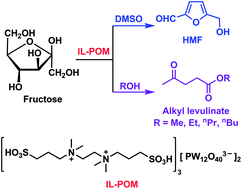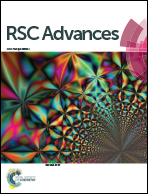Efficient production of 5-hydroxymethylfurfural and alkyl levulinate from biomass carbohydrate using ionic liquid-based polyoxometalate salts†
Abstract
Direct conversion of fructose into 5-hydroxymethylfurfural (HMF) and alkyl levulinate is achieved by making use of ionic liquid-based polyoxometalate salts (IL-POMs) as solid acid catalysts. Among these solid acids, phosphotungstic acid-derived IL-POM shows the highest catalytic performance in both the HMF and ethyl levulinate (EL) formation. A study for optimizing the reaction conditions such as the reaction time and the temperature has been performed. High HMF and EL yields of up to 99% and 82%, respectively, are obtained from fructose under the investigated conditions. Moreover, the generality of the catalyst is further demonstrated by processing representative di- and polysaccharides such as sucrose and inulin with good yields to HMF (76% from inulin and 48% from sucrose) and EL (67% from inulin and 45% from sucrose), again under mild conditions, thereby eliminating the separate hydrolysis step before the dehydration reaction. The catalyst recycling experiment indicates that the adsorption and accumulation of oligomeric products on the catalyst surface results in a partial deactivation of catalyst. The mechanism research reveals that a major pathway for EL formation involves a fructose-to-HMF transformation followed by HMF etherification and rehydration of HMF-ether to give EL. The research highlights an efficient, environment-friendly and recyclable solid acid for biomass valorization.


 Please wait while we load your content...
Please wait while we load your content...